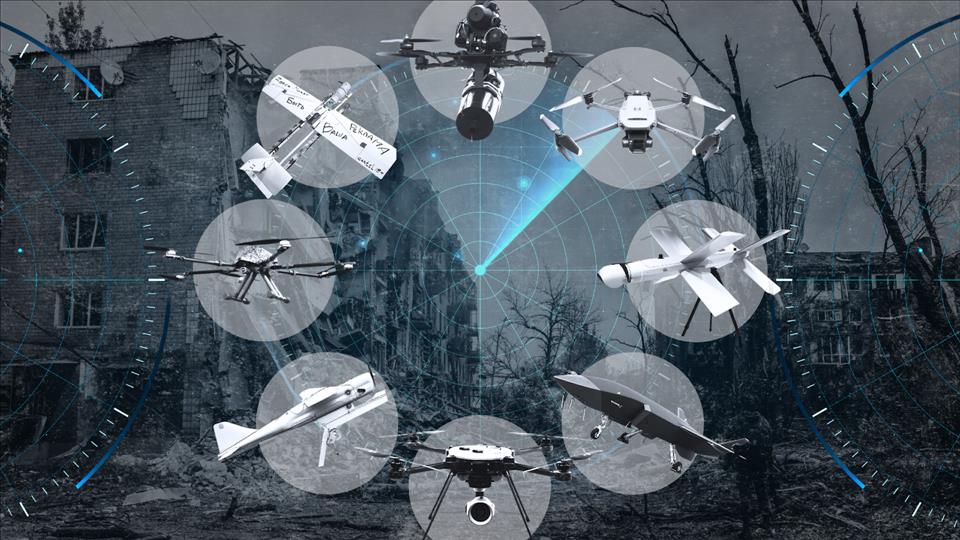
A Visual Guide To 14 Of The Drones Wreaking Havoc In Ukraine, Russia And Beyond
Cheap, mass-produced consumer technology is the foundation for this growth. Militaries are adapting commercial designs to produce a diverse array of deadly tools.
FPV dronesIn sheer numbers, first person view (FPV) drones now dominate the war. Pilots fly them by remote control, sitting in a nearby position and wearing virtual reality goggles to see through the drone's camera.
FPV drones are very fast, highly manoeuvrable, and often attack by crashing into moving targets and exploding. They are used to strike armoured vehicles, to intercept helicopters and hostile drones, drop anti-personnel mines, and to land near roads and wait to ambush enemy vehicles.
Russia's main FPV drone is the Molniya-2. Made from plywood, each one can be assembled for less than a thousand dollars using mostly commercial parts, then armed with repurposed mortar or artillery shells.
Russia plans to make two million FPV drones this year.
To avoid radio jamming, Russia has begun controlling these drones via fibre optic cables up to 40 kilometres long. The battlefield is now littered with tens of thousands of very thin fibre optic cables.
FPV drones are also beginning to incorporate artificial intelligence (AI) – at first to assist pilots, and later for greater autonomy.
The Australian Defence Force (ADF) has so far only engaged with FPV drones by racing commercial devices in multinational competitions.
Multi-copter dronesMulticopters are more general-purpose and easier to operate than FPV drones. They can be used for battlefield reconnaissance, intercepting hostile drones, electronic warfare, GPS jamming, communications relay, delivering packages and dropping small mines or bombs. Many are commercial drones modified with different kits for different missions.
Russia commonly uses small hobbyist quadcopters such as the Chinese-made DJI Mavic 3, the DJI Matrice and the Autel EVO II.
There are also larger purpose-built machines, such as the MiS-150 quadcopter and MiS-35 hexacopter, which can carry payloads up to 15 kilograms. The in-development Buran hexacopter can carry a whopping 80kg.
The ADF operates the R70 Sky Ranger quadcopter for airbase surveillance and defence tasks.
Aircraft-style dronesWinged drones come in two broad groups: one-way (kamikaze or loitering) and reusable.
One‐way drones are used for long‐range strikes against cities, transport and infrastructure. Russia mainly uses the Geran series, which it manufactures in a giant factory 1,000km east of Moscow from designs based on Iran's Shahed drones.
The medium-sized Geran is most common, used for long-range strikes against Ukrainian cities, transport networks, and civilian and military infrastructure.
By late June this year, Russia had fired some 29,000 Gerans, and it can now make 2,700 more each month. Simplified versions with no warhead are also used as decoys to distract air defences – not only in Ukraine, but also in Poland and Romania.
The main reusable drones are the Orlan-10 and the ZALA 421. These provide battlespace surveillance and help coordinate artillery and FPV drone strikes on Ukrainian targets.
Orlan-10s are now being also used as motherships carrying and launching smaller FPV drones.
Another reusable drone is the ZALA Lancet, used for both reconnaissance and strike missions. It is a so-called“loitering munition”: it can be launched, stay in the air for some time, identify targets with an onboard camera, and then attack if its human operator commands. More sophisticated than FPV drones, these are also far more expensive.
The ADF operates several reconnaissance drones similar to the Orlan-10: the Shadow Tactical, Wasp AE and Puma AE.
The ADF has also recently purchased some loitering munitions: the Switchblade 300 and OWL.
The ADF also operates the very large Triton maritime surveillance drone, which has no Russian equivalent, and is developing the Ghost Bat, a high-speed drone able to assist fast jet fighter and strike aircraft.
Counter-drones
Counter-drone technology is in high demand. However, drones are small, fast and numerous, which makes it inherently difficult to defend against them in a comprehensive way.
Counter-drone systems include combinations of warning sensors, backpack and vehicle-mounted electronic jammers, gun systems, surface-to-air missiles, laser devices and electromagnetic pulse systems.
FPV and multicopter drones are too small for fighter aircraft to counter them. However, larger aircraft-like drones are more vulnerable. New air-launched rocket systems now allow fighters to shoot down a dozen Gerans during each sortie.
As drones become even more widespread and diverse, the balance between cheap mass-produced attack platforms and effective, adaptable defences will shape the conflicts of the future.
Image creditsMolniya: Militaer Aktuell;Fibre optic drone: АрміяІнформ/Wikimedia;MiS-150: Lamp of Knowledge/YouTube;MiS-35: United24 Media;R70-skyranger: ELP;Geran-2: Scott Peterson/Getty Images;Orlan-10: Russia/Wikimedia;Zala 421: Airforce Technology/JSC Concern;Zala lancet 3: Vitaly V Kuzmin;Puma-3-AE: Naval Technology/Business Wire;Wasp-AE: Sgt. Janine Fabre, Australian Defence. Infographics: Matt Garrow/The Conversation.

Legal Disclaimer:
MENAFN provides the
information “as is” without warranty of any kind. We do not accept
any responsibility or liability for the accuracy, content, images,
videos, licenses, completeness, legality, or reliability of the information
contained in this article. If you have any complaints or copyright
issues related to this article, kindly contact the provider above.

















Comments
No comment